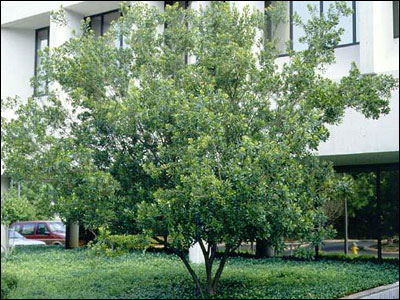
by Matthew Orwat | Nov 5, 2015

Waxmyrtle. Image Credit UF / IFAS Solutions
Myrica cerifera Southern Waxmyrtle, Bayberry is a large shrub to small tree that is now native to much of Florida and much of the Southeastern United States. It was introduced to Europeans in the 1700s and is considered native by many botanical authorities. Sources disagree to the validity of its native status. It is usually found as an understory plant in lightly forested areas, swamps, brackish areas, as well as around old home sites.
It was planted widely in the 18th,19th and early 20th century as a plant for medicinal and industrial purposes. Four pounds of its berries will yield one pound of wax for candle making. When processed, this wax was also used in surgeon’s soap, shaving lather, and sealing wax. Fermented leaves were used to produce a substance which was said to treat fever, stomach aches, and headaches.
Southern Waxmyrtle can reach up to 25 feet but is best maintained as a 10-20 foot multi-trunked shrub or small tree. It can also be trained as a smaller hedge and several dwarf form exist. Landscapes are enhanced by the shrubs’ olive green foliage, leaf aroma, open, rounded form and waxy blue-green berries. Wildlife enjoy the berries as a food source as well. They can provide dappled shade for outdoor entertainment spaces or front entrances.
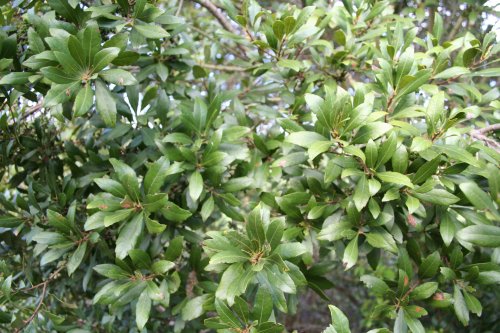
Waxmyrtle Leaves. Image Credit Brent Sellers – UF / IFAS Extension
Another benefit of Waxmyrtle is that it can be used in tough-to-landscape roadside and coastal areas since it is both pollution and salt tolerant and will cease to require irrigation once it is established. ‘Pumila’ is a dwarf cultivar suitable to small spaces.
Waxmyrtle is susceptible to few pests and diseases but can occasionally be attacked by webworms, mites and caterpillars. These can be controlled by pruning out of infested areas, forceful applications of water or Bt (Bacillus thuringiensis for caterpillar). It is also occasionally susceptible to canker on old branches and Fusarium wilt in central and south Florida. It is also considered a weed in pasture situations.
References:
by Matthew Orwat | Sep 9, 2015

Azaleas pruned late in the fall will have little or no bloom in the spring. Image Credit: Matthew Orwat
As fall approaches, our spring blooming shrubs such as gardenia, spirea and azalea begin to look unkempt and overgrown. That means it is time to give them a severe pruning to get them ready for winter, right? Not so fast, take a minute to understand the growth habit of each species before diving in with the pruning shears.
Azalea:
Many do not understand that annual spring azalea bloom could be sacrificed completely by pruning spring blooming azaleas at the wrong time.
Pruning traditional azaleas in the fall will result in a loss of spring bloom the following year because most bloom on previous years’ wood. This means that they flower on growth put on throughout the previous growing season. If a gardener removes the previous season’s new growth, they are removing the blooms as well.
So, when is the proper time to prune azaleas? The ideal time to prune is directly after the spring bloom. This will give the plant enough time to generate abundant new growth, thus maximizing bloom next spring.
Even the developers of the Encore Azalea, a new repeat blooming type, recommend pruning as soon after the spring bloom as possible to maximize bloom set for the following year.
For more information on pruning azaleas or on general azalea culture, please read the UF / IFAS publication Azaleas at a Glance or check out the Pruning Azalea page on Gardening in a Minute.
Gardenia:
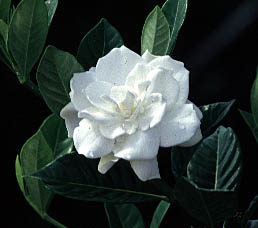
Gardenia, Image Credit Dan Culbert.
Gardenias don’t need much pruning except to remove any dead or non-productive wood, to help them remain bushy, and to remain the same size as other plants in the landscape. Choose a cultivar that will mimic the size of other shrubs, not one too large for the area. Pruning should be done as soon after the summer bloom as possible. Pruning after the beginning of fall will reduce the next year’s bloom production. Know your cultivar. Some cultivars of gardenia flower on new wood as well as old, while some flower on old wood only.
Spiraea:
Regarding spiraea, prune after the bloom as needed. The closer to the late summer or autumn, the greater negative effect pruning will have on bloom quality since spirea set their bloom in early autumn.
I hope this article prevented a few pruning disasters as well as started a thinking process for the act of pruning your landscape plants.
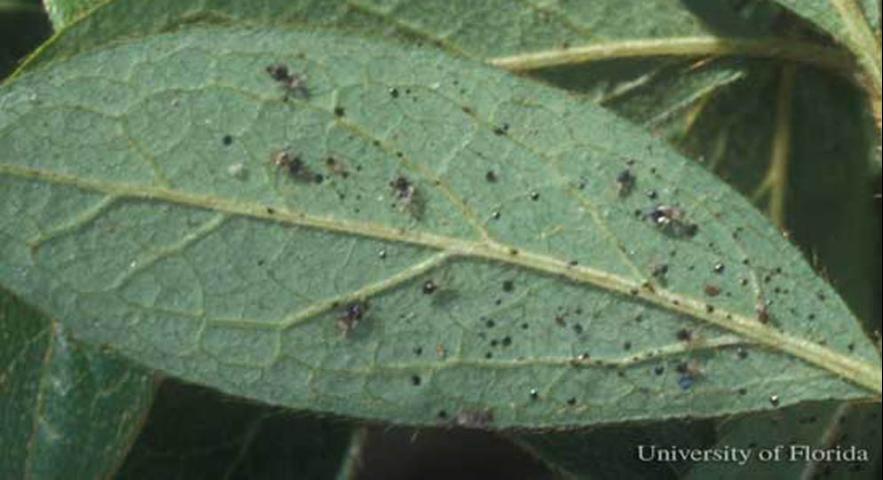
by Larry Williams | Aug 3, 2015
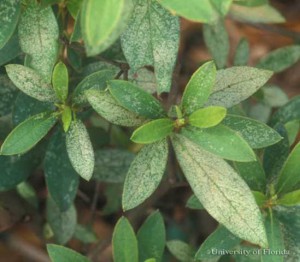
Damage caused by azalea lace bug. Photo credit: James Castner, UF/IFAS
When azaleas are in a garden, azalea lace bugs are sure to follow. The good news is these insects, that discolor the leaves of azaleas, can be controlled.
Lace bugs live on the underside of leaves and damage their hosts by piercing leaves with their straw-like mouthparts and removing the plant’s juices. Infested leaves have tiny yellow spots on the top surface and are discolored with dark, varnish-like excrement and old insect parts on the underside. Azalea plants begin to look unhealthy as insect numbers increase through spring and summer.
Azalea lace bugs spend winter as eggs on the underside of azalea leaves. They hatch in early to mid-March and then begin to feed and develop into adults.
Lace bugs complete their first generation by late April. They increase in number throughout the remainder of spring, summer and fall. These insects can complete three to five generations in a single growing season. In late September adult lace bugs, in their final generation of the season, lay eggs that will carry the population through winter.
The key to easily controlling azalea lace bugs is to properly time control efforts.
Inspect plants in early spring to see if insects are present. Look for leaves that are whitish to yellow on the top surface (they may be mottled in appearance) and have small, dark, varnish-like spots on the undersides. If leave damage is heavy continue to check plants every week for small lace bugs, which should begin to be visible in late March through April.
Early to mid spring is the best time to control the first generation of the bugs. Proper insecticide application timing will reduce need for further sprays during the rest of the growing season.
Insecticidal soap, horticultural oil, neem oil and most synthetic insecticides provide good control of lace bugs on azaleas. When using these types of chemicals, make sure to spray the backs of the leaves.
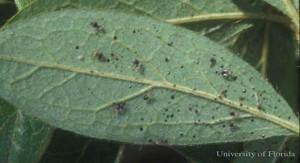
Azalea leaf with lace bugs. Photo Credit: James Castner, UF/IFAS
Systemic insecticides available for use against lace bugs include dinotefuran (Safari), imidacloprid (Bayer Advanced Tree & Shrub Insect Control, Merit) and acephate (Lilly Miller Ready-to-Use Systemic, Orthene). When properly applied, one application may provide season long control.
When using any chemical treatment on plants, it’s best to apply the product during early morning or late evening under cooler temperatures but never during the heat of the day or when the plant is in full sun. And always follow instructions on the pesticide label concerning mixing, application and safety precautions.
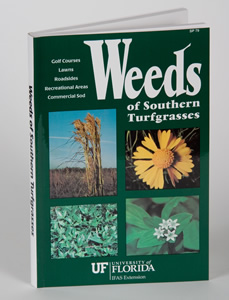
by Taylor Vandiver | Aug 3, 2015
As our world and our lives become more centered on technology it seems that all the information we need is just a touch screen away. After all, you are most likely reading this article from a laptop, smart phone, or tablet. While convenient and portable, there are some places you might not wish to take your electronics and one of those places is in the garden. You may say, “Well Taylor, that’s what they make waterproof, shatterproof, dirt proof, etc. cases for!” and I would say that you’re right. However, technology has many limiting factors such as battery life and screen glare. Now believe me, I am by no means disparaging technology! I come from a generation that considers Wi-Fi as necessary as water and an outlet comparable to oxygen. But there is something to be said for having a book in hand when out in the garden. For one thing your neighbors won’t worry about you as they see you march around the garden with your phone in the air doing the “No Signal Dance”. Also, a book is great to have in order for you to jot down any notes or reflections. I would like to list for you a few books that I often reference when I receive calls from homeowners. These books will cover various topics and all of them can be found on the UF/IFAS Bookstore website, the links for each can be found below. If you have any questions contact your local Extension Office and, as always, feel free to contact me and I can give you a rundown on my collection of favorite reference books!
- New to the UF/IFAS bookstore: “Trees: North & Central Florida” a field guide to 140 common tree species. This sturdy, pocket-sized field guide–the only one of its kind for north and central Florida–is designed for landscape professionals, arborists, naturalists, gardeners, and anyone seeking to know the trees around them. Full color photographs of leaves, bark, flowers and full trees, together with clear descriptions and other information make identifying trees easier than ever. This book also features a handy diagnostic key, an introduction to plant parts, a glossary and a ruler to guide you, whether you’re a trained botanist or a complete beginner.
- “Poisonous Plants of the Southern United States” John W. Everest, Thomas A. Powe, Jr., and John D. Freeman (of Auburn University). Identification of common poisonous plants found along fence lines and in pastures in the Southern United States.
- “Weeds of Southern Turfgrasses” This practical weed identification guide contains 427 color photographs of 193 weed species, their geographical range, and life cycle descriptions. Includes a glossary of taxonomic terms and index of common and scientific names.

- “Disorders and Diseases of Ornamental Palms” Recently revised and updated, this ID deck is a diagnostic tool for landscape professionals and backyard hobbyists. The color photographs and explanatory text helps users identify and distinguish between the nutritional deficiencies, physiological disorders and common diseases of ornamental palms. All palms in the U.S. suffer from disorders and diseases, and identifying the differences can be tricky. These cards feature photographs and descriptions and are cross-referenced for easy comparison between different symptoms and the potential problems causing them. Includes a table of contents and 55 laminated, ring-bound cards.
- “Florida Lawn Handbook: Best Management Practices for Your Home Lawn in Florida” Written in practical language by turfgrass experts, this highly-anticipated new edition offers the most current lawn management information. Color plates identify various grass types, weeds, diseases, and insects—including those that are good for your lawn! Chapters cover selection, establishment, and maintenance for each type of lawn; soil analysis and fertilization; yearly calendars for lawn care and culture; mowing, watering, and calibrating sprinkler systems and fertilizer spreaders; overseeding for winter color; preparing a lawn for drought and low temperatures; safe pesticide application and use; the latest integrated pest management strategies; organic lawn care; and complete, illustrated diagnostic information for weeds, diseases, insect problems, nematodes, and other pests.
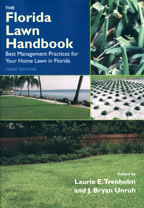
- “Sustainable Gardening for Florida” Gardeners today face a unique challenge: how do you create a beautiful, thriving landscape without over-use of fertilizers, pesticides, and water? Sustainable Gardening for Florida might be the first place to look for answers. This book provides interesting, money-saving ideas to reduce your ecological footprint. It includes chapters on composting and mulching, integrated pest management, water-wise irrigation and rainwater harvesting, preparing your garden for disasters, and all aspects of managing meadows, lawns, trees and shrubs, edible gardens, rain gardens and waterfront gardening.
- “Vegetable Gardening in Florida” From James Stephens, the founder of the Florida Master Gardener Program, this is the one resource you need to successfully grow vegetables in Florida. Whether you’re growing beans, tomatoes, herbs, or any other Florida crop, this guide will take you from site selection and insect management through the harvest and storage of your produce. Useful planting guides, gardening measurement conversions, and organic gardening information are accented with full-color throughout.
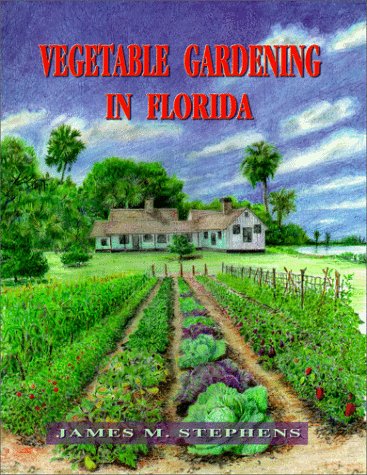
by Julie McConnell | Jun 30, 2015
If you’ve been gardening for more than a few years, you may be confused by UF/IFAS recommendations that conflict with practices you’ve used for years. You aren’t imagining things, we do change recommendations based on the most current research available to help you with your agricultural endeavors.
I want to share a few common mistakes that gardeners make based on old recommendations but that research has shown are not the best choices. Check out the list below to see if you can break an old habit or two!
| Old Habit |
Current Recommendation |
| Throw a little “starter fertilizer” in the hole (or under new sod, seed, etc.) |
It is not beneficial to add fertilizer to plantinghole or under newly installed sod.Quick release (soluble) fertilizer may burn roots if added to planting hole.If applied properly, a slow release fertilizer may be applied to trees and shrubs but should be applied to the top of root ball or mulch following label instructions.Turfgrass grown from seed, sprig, or sod does not use fertilizer efficiently at planting. Wait 30 days to apply fertilizer – after roots have been established. |
| Dig the hole twice as deep and wide as the root ball for trees and shrubs |
1.5 times the width of the root ball is good, but planting too deep can be a death sentence.Planting depth should be 10% shallower than the distance from the topmost root to the base of the root ball. |
| Mulch 3-5 inches deep |
2-3 inches with a very thin layer directly over the rootball (less than 1 inch) and none touching trunk. This is the ideal amount to conserve water and suppress weeds. |
| Native and drought tolerant plants don’t need water |
All plants need water until established – depending on the type and size of the plant, weather, and soil conditions this may take months.Always plan to give a little TLC to newly installed plants no matter how tough they are supposed to be. |

by Gary Knox | Jun 23, 2015
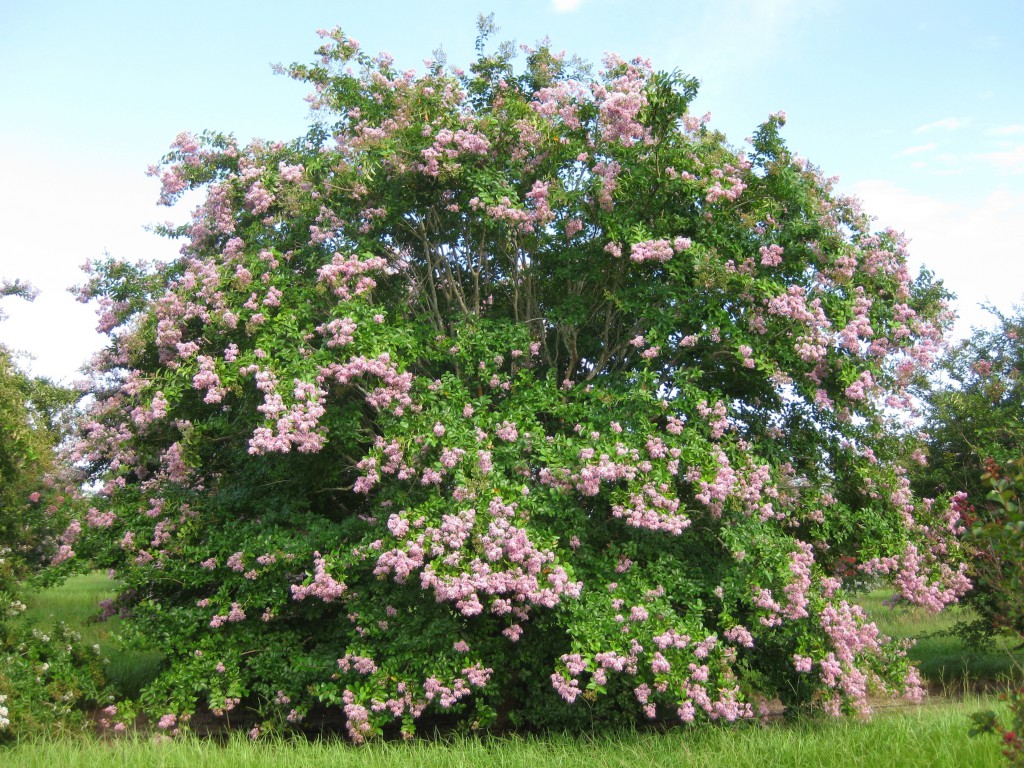
Figure 3. With proper cultivar selection and placement in the landscape, crapemyrtle develops into a beautifully shaped tree that rarely needs pruning. This crapemyrtle is ‘Muskogee’. Image Credit Gary Knox
Crapemyrtle flowering is set to be spectacular this year! While most other garden plants droop from summer’s heat, humidity and heavy rains, crapemyrtle thrives and puts on an outstanding show of flowers all summer and fall. Thanks to modern breeders, we have all sizes of improved hybrid crapemyrtles with flower colors of lavender, purple, white, pink, or red.
Just say “No” to Pruning
Crapemyrtle varieties come in tree-size, patio tree and shrub categories. Tree-size crapemyrtles grow 25 ft. tall and are ideal as flowering trees. Patio tree-form plants (up to 12 ft.) are beautiful as small, flowering specimen plants near patios, walkways, and entrances. Shrub forms (up to 6 ft.) make excellent accents in a shrub border and smaller types are effective as large groundcovers or container plants. Make sure you buy the right size crapemyrtle for your home. Don’t make the mistake of planting a tree-size crapemyrtle in an area too small for its ultimate size, or you’ll find yourself pruning it hard – and often – to keep it from out-growing its place.
Recommended Varieties
Some of the best tree-size (25 ft.) types are Natchez (white), Red Rocket® (red), Sioux (pink) and Apalachee (lavender). Superior patio tree crapemyrtles (12 ft.) are Acoma (white), Cheyenne (true red), Tonto (fuchsia red), Hopi (pink) and Catawba (purple). Smaller shrub (6 ft.) crapemyrtles are hard to find, but Cherry Dazzle® is a nice mounding red and Pixie White and New Orleans (purple) are good selections.
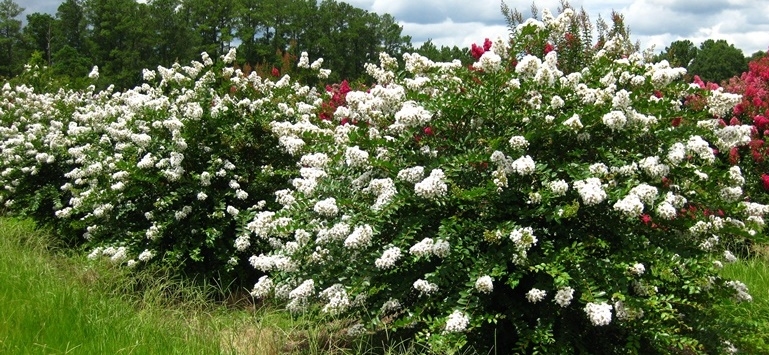
Planting and Garden Care
When it comes to planting, crapemyrtle is very tolerant and forgiving with three exceptions. Firstly, crapemyrtle needs sun to flower freely, so plant it in a site receiving at least six hours of direct sunlight each day. Secondly, crapemyrtle will not grow in wet soils. Finally, never plant crapemyrtle too deep — if you do so, it will punish you by not flowering for years and years. Planting too deep literally smothers the roots, requiring the crapemyrtle to regenerate a new root system in the soil above.
Crapemyrtle is very drought tolerant and almost seems to thrive on neglect. On the other hand, regular watering and fertilizer will help crapemyrtle grow faster and bigger.
More Beauty on the Way!
Breeders are continuing to improve and introduce new crapemyrtles. Many new varieties were released in the last couple years. In particular, watch for new types with purple-burgundy leaf color all summer long! Time will tell which new ones grow best in our area. Stay tuned as the world of crapemyrtle continues to evolve and improve!
*Gary Knox is Professor of Environmental Horticulture with the University of Florida. He is stationed at the North Florida Research and Education Center in Quincy, where he evaluates more than 100 cultivars of crapemyrtle.













